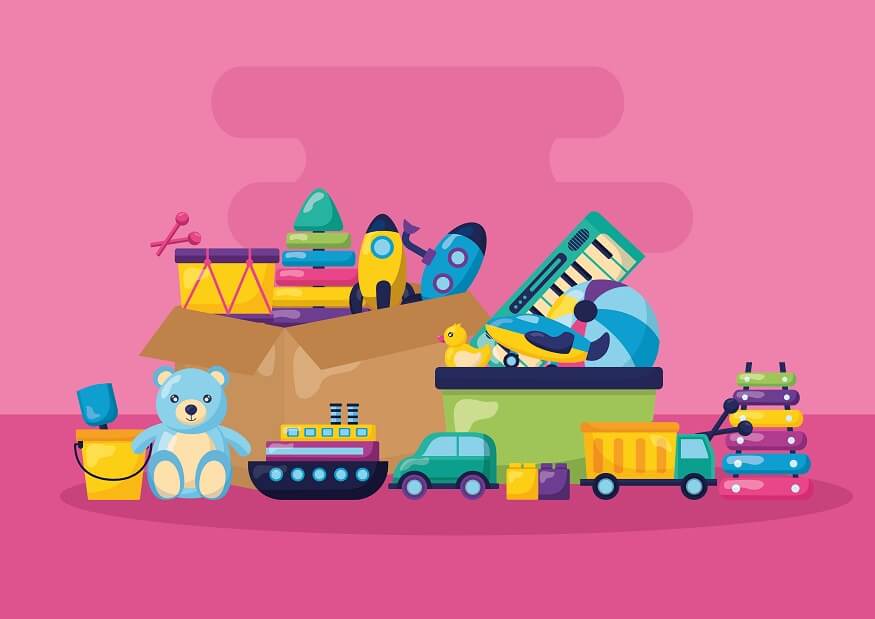Managing the world of toys can be an overwhelming task for parents and caregivers. As much as kids love toys, it’s the parents’ responsibility to ensure the safety of children when handling toys. Children’s toys can become dangerous objects for them. Hence it is necessary to take toy safety measures to help prevent any risks associated with toys. In this blog, we will explore the essential tips to ensure toy safety for kids.
Also Read: Bicycle Safety Tips for Kids
1) Choose age-appropriate toys
Consider your child’s age when purchasing a toy or a game. It is worth a second to read the instructions and warning labels to make sure it’s just right for your child. Manufacturers often provide recommended age labels on their products. These recommendations are not related to a child’s intelligence or maturity but to the safety features of the toy.
Age appropriateness in toys helps you gauge whether
- the toy is safe for your child,
- your child will be able to understand how to play with the toy and
- the toy will match their needs and interests at the stage of development they are in
For instance, toys for children under three years old should not include small parts as they pose a choking hazard. Parents need to respect these labels as they are set based on rigorous testing and safety standards.
Also Read: Water Safety Tips for Kids
2) Quality and Durability
Quality is another key aspect of toy safety. Well-made, durable toys are less likely to break into small, dangerous shards that could pose a risk of injury. Parents should look for toys made of non-toxic materials, which should be stated clearly on the product’s packaging.
Stuffed toys may appear cute and cuddly but can also be harmful to kids. Large stuffed toys can suffocate a baby or a toddler. Monitor your child’s handling of the toy to ensure they do not swallow any parts.
3) Safety standards and Regulations
Look for safety certifications in toys. There are several safety standards and regulations in place to ensure the safety of children’s toys. In the United States, toys must adhere to the federal toy safety standard, known as ASTM F963. This was set up to reduce potential hazards in toys. Similarly, in Europe, toys must comply with the EN71 Toy Safety standard. This covers all aspects of toy safety including mechanical and physical properties, flammability and composition.
In India, check for the ISI mark issued by the national standards body before buying a toy. Since January 1, 2021, the Bureau of Indian Standards (BIS) has banned the manufacturing, storing and sale of non-BIS-certified toys in India.
Key factors to look out for when buying toys are:
- Toys made of fabric should be labelled as flame resistant
- Stuffed toys should be washable
- Lead-free and non-toxic paints on toys
Being aware of these standards can help parents make informed purchasing decisions.
4) Avoid second-hand toys
Second-hand toys may appear to be cost-effective, but they may not meet current safety standards. If however, parents do choose to use second-hand toys, they should carefully inspect them for any potential hazards, check for any recalls associated with the toy, and ensure they are thoroughly cleaned before use.
Also Read: Fire Safety Tips for Kids
5) Buying toys online
With the rise of e-commerce, more people are buying toys online. However, it is important to verify the credibility of online sellers and ensure the authenticity of the product. A cheaper price tag may seem too good to be true, but it often comes with a higher risk of potentially hazardous toys.
6) Safety at home
It is important to educate your child on how to use toys. One of the ways to do this is to supervise their playtime. Teach them to put their toys away after play. Check the toys regularly to ensure they are not broken or unusable.
7) Regular inspection
Parents and caretakers should inspect the toys regularly for signs of any wear and tear. Discard any damaged toys immediately. Look out for splinters and sharp edges in wooden and plastic toys. Stuffed toys should not have loose plastic parts or broken seams to avoid the risk of choking. Regular maintenance, repair and cleaning extend the life of toys and keeps them safe for use.
By understanding and applying these critical aspects of toy safety, parents and caregivers can ensure a safer environment for children to explore, play, and learn. With careful selection and supervision, toys can deliver endless possibilities for enjoyment and enriching development for children.
Also Read: Physical Health Safety for Kids
Conclusion
Ensuring toy safety not only enhances the secure development of our little ones but also nurtures their exploration of the world. A secure play environment fosters creativity, imagination, and innovative thinking.
Let’s bear in mind that the finest toys for children are not merely enjoyable but also tailored to their age and well-being. It is the shared duty of caring parents, ethical manufacturers, and vigilant regulatory bodies to guarantee that our children interact with toys that prioritise safety above all else.









